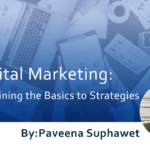What is Affiliate Marketing? Explaining the Basics, Relationship with SEO
contents

You may have heard that it’s possible to generate revenue through affiliate media, but you might be wondering what exactly it entails.
As an SEO consultant, in this article, we will introduce the basics of affiliate marketing, how to get started, its relationship with SEO, and tips for earning more. If you’re looking to understand more about affiliate marketing, this is for you.
Understanding Affiliate Marketing
Affiliate marketing is a performance-based advertising model on the internet. In this model, affiliates promote products or services on their websites or blogs on behalf of businesses. Affiliates earn a commission based on the results set by the advertiser.
How Affiliate Marketing Works
In affiliate marketing, there’s an intermediary service called an “Affiliate Service Provider” (ASP) that connects ‘advertisers’ wanting to sell products/services and the ‘affiliates’ who do the marketing. Advertisers set up their ads based on the products/services they want to sell in the ASP.
Then, affiliates create content using these ads. When a sale occurs, the advertiser pays the advertising fee to the ASP first. Subsequently, the ASP transfers the predetermined commission to the affiliate.
This system allows both advertisers and affiliates to benefit through the intermediary services of the ASP.
Types of Affiliate Marketing
There are various types of affiliate marketing. Here, we introduce the different types of affiliate ads:
Performance-Based
The most common type of affiliate marketing is ‘performance-based.’ In this model, affiliates earn a commission when they meet the performance criteria set by the advertiser.
The criteria for performance can vary by advertiser. For example, common performance criteria in performance-based affiliate marketing include:
- When a product/service sold by the advertiser is purchased.
- When a membership registration occurs.
- When there’s a request for information or an inquiry, etc.
For instance, if an advertiser sets a 15% commission on a product worth 10,000 yen, the affiliate earns 1,500 yen for each sale made through their affiliate link.
In this model, both advertisers and affiliates benefit. Advertisers can sell their products/services without having to advertise themselves, while affiliates earn a portion of the revenue by selling on behalf of the advertiser.
Click-Based
Click-based affiliate marketing generates revenue per click. It’s typically set up as a certain amount per click, and the more visitors click on the ads, the more revenue the site operator earns.
Click-based affiliate marketing is particularly user-friendly for beginners. Initially, when a site is not strong, it’s challenging to earn significant commissions through performance-based models.
However, even with fewer site visitors, small advertising revenues can be earned. For example, even a few tens of yen can be motivating when you start seeing ad revenue from a site you’ve built.
A well-known service for click-based affiliate marketing is Google AdSense. Google AdSense is a click-based advertising service operated by Google. Site operators can apply to use Google AdSense, and upon approval, can start using the service.
However, it’s worth noting that the approval process for Google AdSense has become increasingly stringent over the years. Many site operators have experienced multiple rejections. While Google’s criteria are not clear, meticulous site planning is crucial for approval.
Impression-Based
Impression-based affiliate marketing earns revenue based on the number of ad displays. Unlike performance-based or click-based models, site operators earn commissions simply by displaying ads on their site.
The advantage of impression-based marketing is that it’s the easiest to earn revenue. As long as the site’s visitor count increases, so does the revenue.
However, the downside is that the revenue per impression is minimal, almost negligible. Therefore, relying solely on impression-based affiliate marketing is not practical for sustaining a livelihood as an affiliate.
The Relationship Between Affiliate Marketing and SEO
Understanding SEO is crucial when starting with affiliate marketing. Affiliate marketing and SEO are inseparable. Here, we introduce essential aspects of SEO for those starting in affiliate marketing.
What is SEO?
SEO stands for “Search Engine Optimization.” It refers to various strategies implemented to ensure a website appears at the top of search engine results. While there’s no clear-cut definition of SEO, the goal is typically to appear on the first page of search results, as subsequent pages receive significantly less attention.
SEO is closely linked to Google’s policies. In fact, Yahoo! also uses Google’s search algorithms. Therefore, when considering SEO, it’s important to keep an eye on Google’s trends.
Increasing Revenue Requires Higher Search Rankings
Commonly, SEO strategies are employed to boost search rankings, which in turn increases site visitors. According to a report by SISTRIX, the click-through rate (CTR) varies significantly across different search rankings:
Click-Through Rates by Search Ranking (as of July 14, 2020):
| Ranking position | CTR |
| 1st | 28.5% |
| 2nd | 15.7% |
| 3rd | 11.0% |
| 4th | 8.0% |
| 5th | 7.2% |
| 6th | 5.1% |
| 7th | 4.0% |
| 8th | 3.2% |
| 9th | 2.8% |
| 10th | 2.5% |
(Source: Why (almost) everything you knew about Google CTR is no longer valid – SISTRIX)
There’s a significant difference in CTR between the 1st and 10th positions on the first page. Therefore, the aim of SEO is to achieve the highest possible ranking. However, being number one isn’t always necessary. Depending on the search query, it might be acceptable to rank lower.
For example, a search for “income tax” might show the National Tax Agency’s website in the first position, which might be too complex for some users. In such cases, users might look for more accessible articles on subsequent pages.
Therefore, it’s important to compare your site with competitors in the same search results and consider whether you can provide more value or in-depth information.
Examples of SEO Strategies
Google’s search ranking is determined by over 200 algorithms, making it complex. There is no one-size-fits-all solution for SEO. While there are claims like “Do this to rank first!”, they are misleading. SEO requires continuous testing and adjustments.
However, some effective SEO strategies are known:
- Acquiring backlinks from reputable sites
- Providing high-quality content
- Enhancing the site’s expertise and authority
Implement these strategies and continually test to improve your search ranking.
How to Start with Affiliate Marketing
Starting with affiliate marketing is straightforward and can be done quickly:
- Choose an Affiliate Service Provider (ASP).
- Register with the ASP.
- Place ads.
- Undergo ad placement review.
- Embed affiliate links in articles.
Consider the review period for ad placement and plan accordingly.
How to Generate Revenue with Affiliate Marketing
To earn revenue through affiliate marketing, it’s crucial to optimize your site for higher SEO rankings and enhance user engagement within the site. Here, we will explain in detail how to become profitable in affiliate marketing.
Create Content that Answers Search Intent
In affiliate marketing, it’s essential to create content that meets the search intent. Pages that merely advertise products or services are not user-centric.
For example, consider a page dealing with beauty products. Wouldn’t you feel uncomfortable if it only advertised the benefits, prices, and advantages of beauty products?
Instead, first provide content that addresses the keywords users have searched for. Then, as a solution to the user’s concerns or problems, introduce beauty products. This approach satisfies users and naturally leads to conversions.
Continuously Post Content
To achieve results in affiliate marketing, you need to improve your search ranking. However, it’s not easy to attain high rankings initially. It’s necessary to continuously post content and perform tests.
Therefore, those starting in affiliate marketing should first allocate time. It’s important to consistently create content, like posting one article per week.
Differentiate Between ‘Revenue Articles’ and ‘Traffic Articles’
There are different types of articles: ‘Revenue Articles’ aimed at affiliate conversions and ‘Traffic Articles’ designed to increase site visitors, regardless of conversions.
If you only write revenue articles, your site will struggle to grow. Unless you’re Amazon or Rakuten, a site that only promotes products can be off-putting to users.
Therefore, along with revenue articles, it’s advisable to post traffic articles periodically. Use traffic articles to attract visitors to your site and then guide them to your revenue articles through internal links.
Avoid YMYL Areas
YMYL stands for “Your Money Your Life,” referring to content related to people’s finances, health, or life. Google’s policy now emphasizes authority in YMYL content.
This means that in YMYL areas, pages from reputable companies are more likely to rank higher. Therefore, targeting the following YMYL content areas as an individual is almost impossible:
- Finance
- Health
- Medical
- Legal
- Issues related to race, religion, gender, etc.
Some areas may offer high affiliate commissions, but they are very challenging for individuals to target.
Target Long-Tail Keywords
Long-tail keywords consist of multiple words rather than a single term. They tend to have higher conversion rates.
For example, “refrigerator for single living” indicates a higher purchase intent than just “refrigerator.”Thus, instead of targeting high-volume big keywords, aim for higher conversion rates with long-tail keywords.
Conclusion
Affiliate marketing is a performance-based advertising model on the internet. Advertisers seeking to sell products or services recruit affiliates through an intermediary service called an ASP. When affiliates facilitate a sale through their site’s affiliate link, they earn a commission. To succeed in affiliate marketing, persistence is key. Start by continuously posting content and iterating through tests to achieve results.










![What is a Description? Explaining the Meaning, Writing Style, and Changing Word Count – [2023 Edition]](https://www.switchitmaker2.com/en/wp-content/uploads/2024/09/what-is-description.webp)










